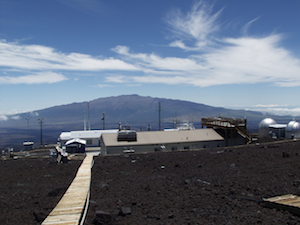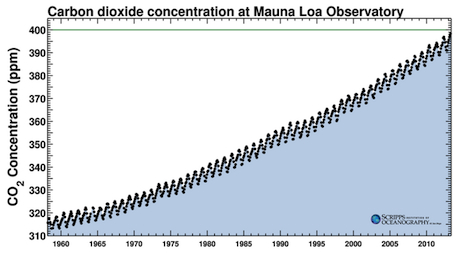CO2 Levels Hit New High
Some milestones are met with cheers. This is not one of those times.
 On May 9, climate scientists from the National Oceanic and Atmospheric Administration (NOAA) reported that the levels of atmospheric carbon dioxide surpassed 400 parts per million (ppm) for the first time in over a million years. The measurements were recorded at the NOAA observatory in Mauna Loa, Hawaii, the oldest continuous carbon dioxide (CO2) measurement station in the world. While more northernly locales had already surpassed this threshold, the observatory is the official benchmark site for monitoring CO2 increases.
On May 9, climate scientists from the National Oceanic and Atmospheric Administration (NOAA) reported that the levels of atmospheric carbon dioxide surpassed 400 parts per million (ppm) for the first time in over a million years. The measurements were recorded at the NOAA observatory in Mauna Loa, Hawaii, the oldest continuous carbon dioxide (CO2) measurement station in the world. While more northernly locales had already surpassed this threshold, the observatory is the official benchmark site for monitoring CO2 increases.
The graph of these increasing levels is referred to as the Keeling Curve, named for Charles David (Dave) Keeling, a pioneering climate scientist who began measuring CO2 levels in March 1958. The increase in CO2 levels, from the initial reading of 316 ppm to today's 400 ppm concentrations, is primarily due to the combustion of carbon-based fuels.

Concentrations of atmospheric CO2 are increasing at an accelerating rate from decade to decade. With 400 in the rearview mirror, the 450 ppm precipice looms closer, a dangerous tipping point, according to scientists like Scripps Institution of Oceanography researcher Ralph Keeling who continues the work started by his late father.
"I wish it weren't true," he said, "but it looks like the world is going to blow through the 400-ppm level without losing a beat. At this pace we'll hit 450 ppm within a few decades."
With rising CO2 comes rising temperatures and other deadly climate change scenarios.
"It takes a while for the climate to catch up to the CO2 level," Keeling told KPBS. "There's a lot of lag in the climate system, so even if we could keep CO2 without rising beyond 400, we'd still have some significant additional climate changes in store."
According to Keeling and other leading scientists, the window of opportunity for avoiding catastrophic effects has already closed. Events such as rising sea levels, droughts, floods and heatwaves, they can only be mitigated.
Scientists had been calling for measures that would limit temperature change to a 2-degree Celsius rise. Keeling reported that it's very likely too late for that.
"I think the opportunity to achieve that was more or less in the past decade and now it's probably not really realistic that we'll get there," he said.
The time to act is now, according to Tim Lueker, an oceanographer and carbon cycle researcher, as well as a long-time Scripps CO2 Group member. He states:
"The 400-ppm threshold is a sobering milestone, and should serve as a wake up call for all of us to support clean energy technology and reduce emissions of greenhouse gases, before it's too late for our children and grandchildren."










